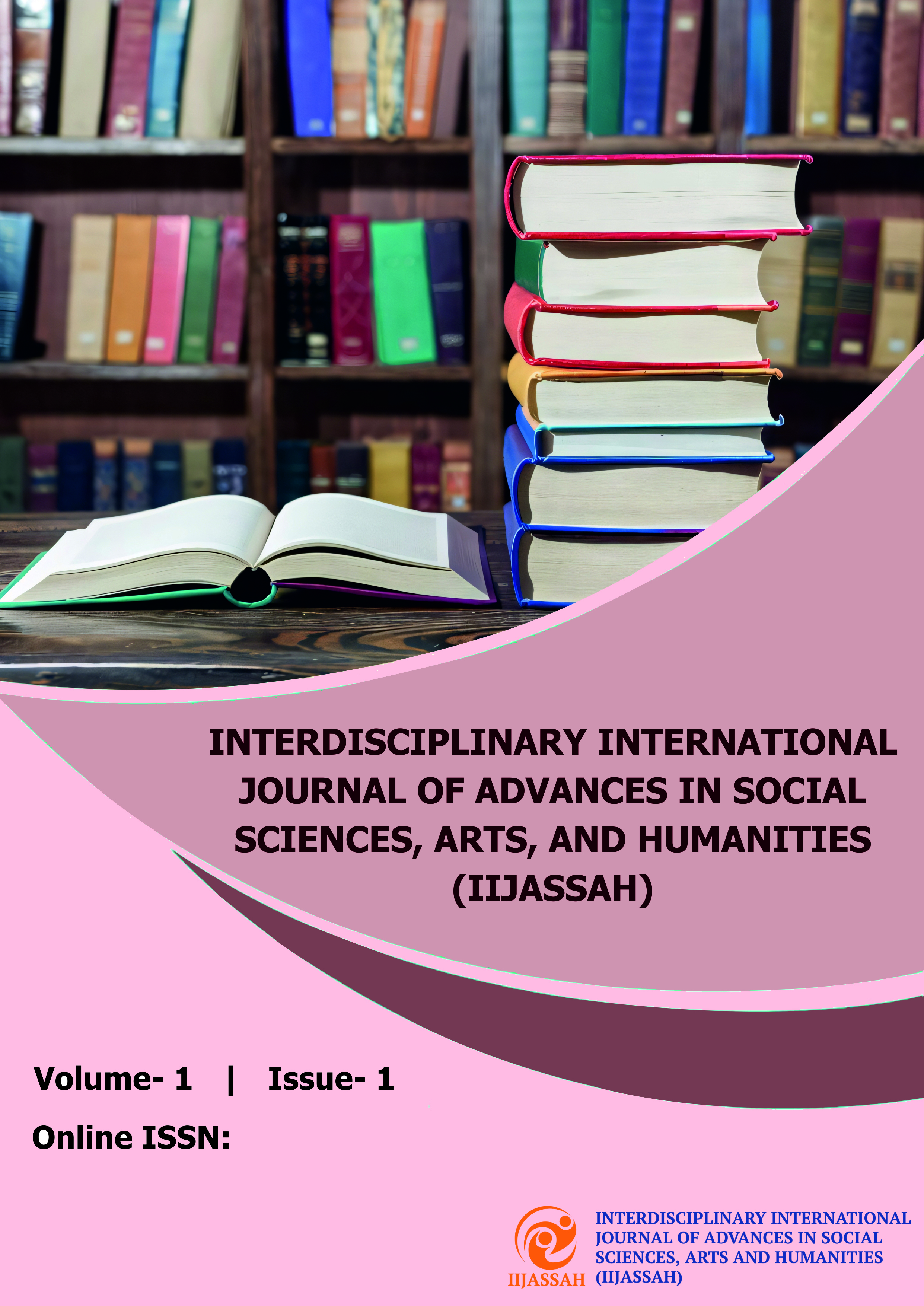Abstract
This study examines how women in Self-Help Groups (SHGs) utilize indigenous resources for environmentally sustainable entrepreneurship, despite socio-economic challenges in rural India, with a focus on Murshidabad district. Since the launch of the Integrated Rural Development Programme (IRDP) in 1980 and its transformation into the National Rural Livelihood Mission (NRLM) in 2015, SHGs have played a crucial role in empowering marginalized women through financial inclusion, skill development, and access to credit. This micro-level research explores how SHGs, particularly in six Gram Panchayats, foster eco-friendly businesses by leveraging local knowledge and resources, such as jute and mango production, to drive sustainable development. The study is grounded in Max Weber's Social Action Theory, emphasizing the goal-rational actions taken by women in SHGs to create sustainable businesses that align with environmental and economic sustainability goals. The findings reveal that SHG-induced entrepreneurship not only promotes women’s empowerment but also contributes to green finance, enhancing rural development in a socially, economically, and environmentally sustainable way. Through primary data analysis, the study highlights the positive impact of SHG participation on overcoming socio-economic constraints and developing sustainable enterprises. The use of indigenous resources and grassroots mobilization supports both current and future environmental sustainability, offering a model for green development and poverty alleviation in rural India.
Introduction
It is vital to empower and support women for innovation, prosperity, and gender equality in today's global environment because they are increasingly assuming key roles in business, boosting economic growth, improving family livelihoods, and encouraging entrepreneurial growth through versatility, confidence, and skill (Bhovi, Kishore & Jessvitha, 2024). In India development started as a new pathway of employment creation and asset formation for marginalised groups through IRDP in 1980. In 1999 IRDP was transformed into SGSY (Swarna Jayanti Gram Swarojgar Yojana). SGSY enhanced self-employment by organising the poor in self-help groups (SHGs). However, SGSY was remarkably successful only in places where systematic mobilization of the rural poor into SHGs together with their capacity building and skill development was highlighted Considering the huge task and relative nonachievement in other areas the union government approved the restructuring of SGSY as the NRLM (National Rural Livelihood Mission) in 2015. NRLM organised the rural poor through the formation of women in SHGs and their networks together with their financial inclusion and access to institutional credit to eradicate extreme poverty, promote gender equality, empower women, and ensure environmental sustainability.
The focus of this micro-level study is to portray how indigenous resources are being used collectively by Self Help Groups (SHGs) women for environment-sustainable entrepreneurship despite the bottlenecks of the existing socio-economic structure of our economy. Existing literature often focuses on the constraints and challenges faced during women’s entrepreneurial development in existing economic-social-institutional arrangements (Moseset al., 2015). Firstly, sustainable development had been interpreted as an ecological vision (Ahman, 2013). Today it is a multifocal agenda strongly linking environmental, social, and economic notions. It ensures that the ‘source' and 'sink' functions of the environment are not degraded. It also ensures that the extraction of non-renewable resources is minimized and national resource capital remains intact. The marginalised women in self-help groups in these particular study areas logically established their goal orientation by establishing eco-friendly small and micro-level businesses. Basically, this is a primary survey based on the study in six Panchayat areas where the use of indigenous knowledge and resources is generating sustainable development in an eco-friendly way has been identified. In addition to providing useful tools for audience engagement, personal branding, and collaboration, as well as policy and business recommendations to advance gender equality in the business world, the strategic use of social media has a profound impact on fostering gender equality and empowering women entrepreneurs (Akpuokwe, Chikwe, & Eneh 2024).
Connection with Theory
There exists a gap in how some women entrepreneurs use indigenous entrepreneurial resources for sustainable development despite these constraints. The discourse on women’s micro-entrepreneurship access to entrepreneurial resources is situated within the ambit of Social Action Theory by Max Weber to explain the subjective meaning attached to accessing resources for entrepreneurial development. According to Weber, there are four ideal dimensions of social actions. These dimensions are emotional action, traditional action, goal-rational action, and value-rational action. Rational action is guided by the consideration of ends, means, and secondary consequences. Marginalised women entrepreneurs in this particular study area logically establish goal orientation by establishing sustainable eco-friendly small and micro-level businesses. Hence, the logical actions taken jointly by women group members are based on the assumption of certainty of occurrence for a desired consequence, i.e., sustainable entrepreneurial development. One such logical action is the access and use of indigenous entrepreneurial resources for economic activity with fulfilling the targets of economic and environmental sustainability. There is different dynamic, rational actions taken by women, those are helping them to access resources. These actions are end-in-view of logical actions leading to income generation, wealth accumulation, return from risks, social empowerment self-efficacy, and ultimately to social justice.
Facility of low-cost credit to the women through self-help groups (SHGs) has been incorporated by governments, international funding agencies, and development banks as a crucial poverty-reduction strategy. Under this approach, similar to the design of joint-liability microfinance programs, poor women are mobilized into small groups, through which they can access subsidized credit, financial assistance, information about income opportunities and government programmes, and other assistances such as skills enhancement. SHG credit interferences are likely to make the financial situation of poor better by dropping the cost of service of existing debt and by increasing access to credits for consumption-smoothing and productive purposes. Implementation of these programs helps to build women’s social networks, create ability for cooperative action, and to increase their role in decision-making both within and outside the household. Inspite of deplorable economic conditions, less education, cultural and social constraints, lack of information and technology etc. the resurgent endeavour of SHGs in motivating sustainable entrepreneurship using indigenous knowledge and resources and hence elevating women empowerment is the core area of the study.
Case Study
The study reviews how SHG induced entrepreneurship can definitely act as a catalyst by acting as an effective conduit for channelising green finance to these sectors in alignment with the national policies and goals to empower women, and, encouraging sustainable environmental projects through management of sustainable indigenous natural resources. This study using primary data, attempts to investigate how SHGs induced sustainable environment friendly entrepreneurship can enhance our country's economic future and further tries to analyse how these environments sustainable entrepreneurship enhances comparative advantage in trio development – Economic, Social and Environmental in different Gram Panchayats in Murshidabad. This study also finds that the projects have percolated to the grassroot level. It is further observed that the participation in SHGs has a positive effect on sustainable economic development vis-a-vis women empowerment of the poverty stricken marginalized rural mass. Being situated on the left Bank of the river Ganges the district of Murshidabad is very fertile considering the climatic conditions necessary for jute and paddy cultivation. Murshidabad is one of the major producers of this biodegradable crop and staple food vis-a-vis mangoes which has a legacy since the Nawab era. In this particular study, we also see that women have been using jute as one of the chief ingredients for the production of ropes and bags. Mango cultivation by self-help groups adds to the legacy. Production of puffed rice by the members of the group meets the local and regional needs in an eco-friendly way.
| Name of the Sangha | Business | Idea |
| Sabala Sangha | Nursery Plantation | Own BDO Office |
| Chetona | Fishery Cattle rearing | NGO Ram Krishna Mission |
| Seva Sangha | Puffed Rice Cattle rearing | Own |
| Anushandhan | Cattle rearing | DRDO |
| Deepsikha | ‘Bori', water hyacinth bags, incense sticks, cattle rearing | DRDO. Ram Krishna Mission |
| Ma Bhagabati | Mushroom cultivation, milk selling, jute bags, bori making | DRDO |
| Jagaron | Nursery, poultry | DRDO, Ram Krishna Mission |
The study finds that over the years the members of SHGs have been successful in overcoming the social constraints of society and enhancing environment-sustainable entrepreneurship utilising indigenous knowledge and resources. It is further observed that not only have the SHGs percolated to the grass root level, but the participation in groups has a positive effect on women empowerment and sustainable economic development of the poverty stricken marginalized rural mass in Murshidabad.
| Name of the Sangha | Name of the Panchayat | Present Activities | Indigenous Resources | Hegemony of Patriarchy |
| Deepsikha | Chaitanyapur-2 | Ropes from jute, bags from water hyacinth, bori, nursery. | Jute, water hyacinth. | Decline of allotted NREGA jobs by local panchayat |
| Jagaron | Chaitanyapur-1 | Mushroom cultivation, lentil machine, puffed rice. | Mango garden | |
| Ma Bhagabati | Mohula-1 | Jute work, mushroom cultivation, bori, puffed rice. | Jute, paddy for puffed rice. | |
| Seva Sangha | Bhabta-1 | Puffed rice, nursery. | Paddy | |
| Chetona | Sujapur Kumarpur | Goat supply to panchayat and Maha sangha poultry, nursery | Pond | Plan of fishery stopped by local youths and panchayat |
| Sabola Sangha | Mirzapur-1 | Poultry farm, plantation of trees, goat rearing. | ||
| Anusandhan | Mohula-2 | Cattle rearing, Stitching. |
Mohua I
In the Mohula I area, 160 groups comprising around 4000 members are using jute as one of the chief ingredients for the production of ropes and bags. Together with that mushroom cultivation, cattle rearing (cow and goat), selling of milk, and poultry, and collecting rice from the farmer are the major sustainable activities of the self-help group which also caters to local and regional needs.
Chaitanyapur 1
Chaitanyapur 1 area comprising around 3500 members also engaged in the production of jute bags and ropes, mango plantation, cattle rearing, production of local delicacies using local resources, poultry, and other local needs like "bori "making incense sticks using local resources and catering to the local needs.
Sujapur
Kumarpur and Bhabta II areas are using paddy for making puffed rice vis-a-vis cattle rearing, poultry, and selling of milk. SHGs in Chaitanyapur II and Mohula I areas have set up lentil mills to meet the local demand for lentils using local production in an economical and environmentally sustainable way.
Discussion
The findings from this study highlight the transformative potential of Self-Help Groups (SHGs) in fostering sustainable entrepreneurship among marginalized rural women in India, particularly in the district of Murshidabad. By leveraging indigenous resources such as jute, paddy, mangoes, and local craftsmanship, these women-led SHGs have established eco-friendly micro-enterprises that align with the broader goals of economic, social, and environmental sustainability. The effective participation of women inside SHGs to establish localised solutions to both economic and environmental concerns is one of the research's major findings. Through the SHGs, women are now able to work in jobs producing jute bags, cultivating mangoes, and producing puffed rice—activities that not only fill up local requirements but also encourage the use of sustainable and biodegradable resources. This is in accordance with India's larger goals for sustainability and illustrates how community-based initiatives may enhance lives while boosting environmental conservation. SHGs have been effective in promoting sustainable business, yet there are still obstacles in their way. Women's socioeconomic limitations, which include restricted access to technology, low levels of education, and cultural barriers, provide enormous challenges.
However, as the report demonstrates, SHGs have been able to get beyond a lot of these obstacles with the help of low-cost funding, capacity-building programs, and strategic alignment with national green finance policies. This demonstrates how important institutional backing is to the fulfilment of these kinds of grassroots projects. The findings of the study also align with Max Weber's Social Action Theory, which describes how goal-oriented behaviours can result in predictable outcomes—sustainable development in this case. SHG women are exemplary examples of goal-rational behaviour as they have rationally and collaboratively pursued business endeavours that achieve a balance between environmental sustainability and financial viability. Their initiatives also demonstrate the growing significance of social networks and collective efforts in overcoming poverty and gender disparity in rural India. SHGs are a successful way of directing green capital and resources into women-led, sustainable enterprises in rural regions. These organizations are improving economic opportunities for marginalized women and furthering social and environmental objectives by encouraging the use of indigenous resources and environmentally sustainable techniques. The study emphasizes how crucial it is to keep funding and supporting Self-Help Groups (SHGs) in order to boost their abilities to foster sustainable development at grassroots levels.
Limitations
There are definitely number of constraints to beware of, yet this study provides insightful information about how Self-Help Groups (SHGs) might support sustainable business by utilising indigenous assets. Firstly, the research's geographical focus is restricted to a few Gram Panchayats in Murshidabad; this may not accurately reflect the experiences of SHGs in other parts of India. As a result, it's possible that the results cannot be applied in their entirety to other regions with different socioeconomic, cultural, or environmental conditions. Secondly, the study depends on primary data gathered via telephone interviews and field surveys, which are prone to biases such as individual prejudices, imperfect respondent recollection, or reluctance to share sensitive information. This might have an impact on the reliability and correctness of the data gathered, which might restrict the analysis's conclusions. Lack of comparison with alternative development models or entrepreneurial tactics used by women outside of SHGs is another drawback. It is challenging to evaluate the efficacy of SHG-based entrepreneurship in contrast to alternative models without such a comparison. The study also highlights the use of regional knowledge and resources; however, it skips over exploring the difficulties in integrating modern technology, getting access to advanced skill training, and integrating with contemporary market dynamics. This gap can miss chances to grow or improve the long-term viability of entrepreneurial endeavours. Finally, the study places more of an emphasis on environmental and economic sustainability than it does on the long-term political and social empowerment of women outside of the business area. SHGs offer a platform for empowerment, but there is still a lack of research on more systemic issues such inequality in gender, institutional hurdles, and problems implementing regulations. Further studies may address such limitations by broadening the study's geographical reach, integrating comparative frameworks, and exploring the relationship between SHG-driven entrepreneurship and contemporary technology breakthroughs as well as more extensive structural concerns.
Conclusion
Access to and use of indigenous resources for economic activity helps them to fulfil their targets of economic and environmental sustainability. The use of locally available resources, climatic conditions, and socio-cultural values provide ample scope for indigenous women to enhance the development of rural India taking into consideration the ecosystem and consumption patterns of the local people. The study also contributes to the literature by showing how environment sustainable endeavours of SHGs using indigenous resources vis-a-vis enhancing women entrepreneurship in a sustainable way. So, considering the benefits of indigenous resources both for the local as well as contemporary society the study has tried to identify how local but poorly educated women have deployed indigenous resources overcoming challenges in a sustainable way. and how SHGs can guide the flow of social funds to production activities conducive to green development, and promote more resources to be allocated in the field of pollution-free production and environmental protection. The use of indigenous resources at the grassroots level mobilised by green finance to ensure a better environmental outcome and a more resilient future is the focus of the study.
Future Scope
In India, there exists a substantial possibility to broaden the reach of sustainable entrepreneurship facilitated by Self-Help Groups (SHGs), specifically in rural areas. In order to discover how comparable models might be replicated in different districts and states, future research can concentrate on extending the geographical areas under study. A more thorough understanding of the ways in which different social, cultural, and environmental factors impact SHG entrepreneurship can be achieved by expanding the study to other regions and making comparisons. Furthermore, by broadening the use of indigenous resources, it will be possible to investigate novel possibilities for the development and promotion of environmentally conscious and sustainable local products. Future research can evaluate how modern technology and digital platforms can improve SHG performance and market outreach, especially when it comes to facilitating the connection of rural women entrepreneurs with international markets. This might increase the scalability of SHG goods and services, which would greatly aid in the reduction of poverty and the empowerment of women. Another area that could use development is the inclusion of SHGs into larger national and international frameworks for financing green projects. In order to provide SHGs with access to finance for environmentally sustainable initiatives, policymakers and financial institutions can develop specialised financial tools. Achieving national objectives for climate action and sustainable development would benefit from this. Longitudinal studies could track the long-term impacts of SHG-induced entrepreneurship on economic, social, and environmental dimensions, providing insights into how these groups can continue to evolve as key players in rural development. This future research can also evaluate how the initiatives contribute to gender equality and the social mobility of marginalized groups. There is ample opportunity for further research and policy development to ensure that SHG-led entrepreneurship not only empowers women but also contributes to the sustainable development of rural India in alignment with national and global goals. Environment sustainable endeavours are gradually gaining importance in rural India and this study shows how the leadership potentials of SHGs helps in promoting and strengthening sustainable environmental projects by management of sustainable natural resources and ensuring green finance. So SHGs should be promoted and backed by proper green financial and social support. Green Projects must be given to the SHGs to utilise the huge manpower at the grass-root level and generate self-sustaining growth in an environment sustainable way. The green project meets the needs of the present generation without compromising the needs of the future generation.
Conflict of Interest
The author declares that they have no conflict of interests.
Acknowledgement
We would like to express our deep gratitude to all those who contributed to the successful completion of this study. First and foremost, we are grateful to the women members of the Self-Help Groups (SHGs) in the Gram Panchayats of Murshidabad, whose efforts and commitment toward sustainable entrepreneurship served as the backbone of this research. Their stories, insights, and experiences provided invaluable data for the study. Their dedication and resilience, despite numerous socio-economic challenges, are truly inspiring and have added great depth to this work. Special thanks to our academic advisors and mentors for their guidance, encouragement, and constructive feedback throughout the research process. Their expertise and unwavering support have been crucial in refining my ideas and methodology. Finally, we are thankful to our family and friends for their constant encouragement, patience, and belief in us throughout this journey. This study would not have been possible without their continuous support.
References
- Åhman, H. (2013). Social sustainability–society at the intersection of development and maintenance. Local environment, 18(10), 1153-1166. https://doi.org/10.1080/13549839.2013.788480
- Akpuokwe, C. U., Chikwe, C. F., & Eneh, N. E. (2024). Innovating business practices: The impact of social media on fostering gender equality and empowering women entrepreneurs. Magna Scientia Advanced Research and Reviews, 10(2), 032-043.
- https://doi.org/10.30574/msarr.2024.10.2.0042
- Bhovi, B., Kishore, M. N., & Jessvitha, L. (2024). WOMEN ENTREPRENEURSHIP. IJRAR-International Journal of Research and Analytical Reviews (IJRAR), 11(2), 900-903
- Tupe, N. B. (2014). Triangular attitude of patriarchy: A major issue of lifelong learning among women in India. Business and Management Research, 3(4), 11-25. https://doi.org/10.5430/bmr.v3n4p11
- Moses, C., Olumuyiwa, O., Mosunmola, A., & Mayowa, A. (2015). Entrepreneurship education and poverty alleviation: Impact analysis of Covenant University Graduate between 2006-2013. development, 6(14), 4.
- Weber, M. (1978). Economy and society: An outline of interpretive sociology (Vol. 1). University of California press.












